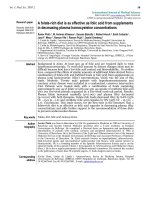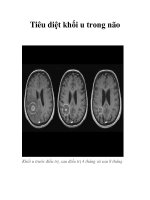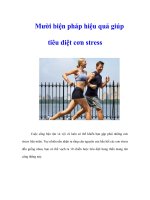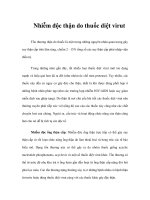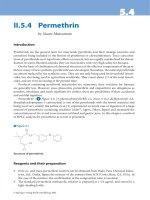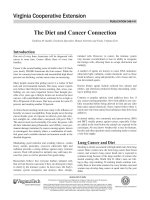46 contest prep DIet periodization
Bạn đang xem bản rút gọn của tài liệu. Xem và tải ngay bản đầy đủ của tài liệu tại đây (646.72 KB, 21 trang )
UNIVERSITY
Contest Prep
Diet Periodization
(Cheat meals, Refeeds,
Diet Breaks, Carbohydrate
Cycling)
Lesson Overview
• What is Intermittent dieting versus continuous Dieting?
• How do we physically adapt during energy restriction?
• What is the research on short term 24-72 hour refeeds?
• Fat loss, muscle retention, hormones, adherence, performance
•
•
•
•
•
•
•
•
•
What is the research on long duration refeeds > 7 days “diet breaks”?
Why is the current research limited for physique competitors?
What are the draw backs to using refeeds?
Practical takeaway points from the literature
How and When to apply 24-72 hour refeeds
How and When to apply diet breaks
How and when to apply High and low day rotations
How and what to monitor for refeed peak week practice
Sample contest prep diet and refeed diet
Defining the Terms
Continuous Energy Restriction (CER): Continuous calorie deficit daily
to achieve weight/fat loss
Intermittent Energy Restriction(IER): alternating periods of energy
restriction with days at or above maintenance calories
Cheat meals/days: No tracking of intake for a meal or day allowing a
large influx of calories
Refeed: Strategic 1-3 day period of calories at or slightly above
maintainance calories primarily carbohydrate based.
Diet Breaks: Strategic 4-7+ days of calories at or slightly above weight
maintenance
Energy Restriction Adaptive Components
Purpose of Intermitting Diet Approach is to offset adverse physiological effects of prolonged dieting and low
body fat levels we see in Relative Energy Deficiency in Sport Syndrome (RED-s)
Increased Hunger
• Increased Ghrelin
• Decreased PPY, Insulin, Leptin
• Decreased dietary adherence
Decreased Energy Expenditure
• Decreases in resting metabolic rate, thermic effect of food, Resting metabolic rate, NEAT, exercise activity
thermogenesis
• Decrease body mass and fat free mass
• Increase cortisol
Decreased Muscle Mass
Decrease testosterone and IGF-1
Decreased training performance
Decreased mood, energy, libido, menstrual function, sleep quality and duration
Decrease in LH, FSH, sex hormones
Body builders anecdotally state benefits:
prevent downgrade in energy expenditure dieting
replenish intramuscular glycogen
mental refreshment
improved fat loss
muscle retention
Research on Short Term Refeeds 24-72 hours
Fat loss effects?
Potential Benefits and Harms of Intermittent Energy Restriction and Intermittent Fasting
Amongst Obese, Overweight and Normal Weight Subjects-A Narrative Review of Human and
Animal Evidence (Harvie 2017)
• 13 studies comparing CER and IER
• Overweight individual
• Comparable reduction in body weight when energy intake is matched
Muscle Retention?
Effect of Alternate-Day Fasting on Weight Loss, Weight Maintenance, and Cardioprotection
Among Metabolically Healthy Obese Adults: A Randomized Clinical Trial (Trepanowski 2017)
• Randomized control trial 100 adults, overweight or obese
• Alternate day fasting or CER for 24 weeks
• FFM to total mass ratio same between groups
Intermittent Energy Restriction Attenuates the Loss of Fat Free Mass in Resistance Trained
Individuals. A Randomized Controlled Trial (Campbell 2020)
• 17-week trial in resistance trained males and females
• Group 1 CER 25% deficit 7 days per week
• Group 2 IER 35% deficit 5 days, maintenance calories w/ carb increase for 2 days per
week
• IEF group retained more FFM (0.9kg) and CER group greater decrease in RMR (4%), IER
group maintained RMR
• body composition changes could be artifacts of the refeeds (glycogen increase, dry
muscle tissue weight) Current statistical analysis is under review (Peos 2020)
Research on Short Term Refeeds 24-72 hours
Adherence?
The benefits of behaving badly on occasion: Successful regulation by planned hedonic
deviations (Coelho, 2016)
• 7-day trial IER (6-day 1300kcal, 1-day 2700kcal vs CER (7 days 1500kcal) energy
equivalent
• IER group demonstrated a higher-than-expected self-regulatory ability
• Improved long term adherence
Menstrual Cycle?
Slow restoration of LH pulsatility by refeeding in energetically disrupted women in
women (Louks 1998)
• 5 days low energy availability (10kcal/kg lbm) in women (suppressed LH 57%, T3
22%)
• 1 day (90kcal/kg lbm)
• single day spent far above maintenance calories could not reverse LH pulsaltilty or
T3, commonly involved in menstrual cycle dysfunction in energy restriction.
Short-term fasting affects luteinizing hormone secretory dynamics but not
reproductive function in normal-weight sedentary women (Olson 1995)
• Women 27.6% body fat
• Fasted for 3 days on cycle day 7 to 9
• Refeed on (35kcal/kg/day) for 48 hours
• maintenance calories did begin reverse LH pulsatile changes from fasting
Research on Short Term Refeeds 24-72 hours
How much glycogen do we use?
•
15 sets of multi joint quad exercise and 5 sets of single joint quad exercise all to failure caused a 26% decrease in muscleglycogen (Tesch 1986)
•
3 rounds of full body circuit (3 set leg press, 6 sets leg extension, 6 upper body lifts, 10 reps at 80% 1RM) caused a 36% decreased in vastus lateralis
muscle glycogen levels (Roy 1998)
Training glycogen depleted?
•
Glycogen depletion followed by 2-day high(7.6g/kg ) or low (0.34g/kg) CHO diet, Short rest periods, sets to failure likely more intramuscular acidosis,
fasted state, no difference b/w conditions (Mitchell 1997)
•
Glycogen depletion following 2-day CHO restriction 1.2g/kg or control, CHO restriction reduced total repetitions performed in squat testing no change on
isokinetic knee torque during leg extensions (Leveritt 1999)
Carbohydrate Restriction: Friend or Foe of Resistance-Based Exercise Performance? (Cholewa 2018)
•
Low muscle glycogen negative effects low volume <8 sets and high intensity>85% strength training
•
Increase blood glucose prior to high volume >10sets and moderate intensity 50-75% increase work capacity
•
Less server CHO restriction (30-40% kcal) does not impact hypertrophy outcomes, but more severe restriction, however 10% CHO can.
Breakfast: Omission Reduces Subsequent Resistance Exercise Performance (de Bin Naharudin 2020)
•
Resistance trained males, 4 sets squat or bench press 2 hours after consuming water or breakfast or low energy placebo after an overnight fast
•
Back squat performance 15% higher after placebo and breakfast; Bench press no difference
•
Hunger suppressed and fullness elevated during placebo and breakfast; Performance enhancement likely psychological and not glycogen related
How long does it take to load CHO and improve performance?
Carbohydrate loading in human muscle: an improved 1 day protocol (Bussau 2002)
•
Glycogen replenishment needs 10g/kg carbs in a single day to fully max glycogen storage levels
•
8 endurance trained males
The Effect of a Moderately Low and High Carbohydrate Intake on Crossfit Performance (Escobar 2016)
•
CrossFit athletes increased CHO to 6–8 g/kg/day for 3days demonstrated increased repeptions during a 12 minute test protocol vs control consulming
<6g/kg/day
Carbohydrate Needs for Visual Improvements?
•
Carbohydrate Loading Practice in Bodybuilders: Effects on Muscle Thickness, Photo Silhouette Scores, Mood States and Gastrointestinal Symptoms (Wilson,
2019)
•
Bodybuilder day prior to competition consumed 8-12g/kg of CHO OR ~5g/kg CHO
•
Muscle girth, thickness improved in CHO loading group only; Panel of Bbing judges rated loading CHO group; visually improved compared to low CHO
intake
Research on Short Term Refeeds 24-72 hours
Leptin levels and energy expenditure?
Effects of short-term carbohydrate or fat overfeeding on energy
expenditure and plasma leptin concentrations in healthy female
subjects (Dirlewanger 2000)
• 10 healthy lean females, 3 day isocaloric, 3 days carb over feeding, 3
day fat overfeeding
• CHO overfeeding increased leptin 28% and 24hr EE 7%, RMR and
NEAT not effected
• FAT overfeeding did not impact leptin of EE
• 40% calories over maintenance levels
Response of leptin to short-term and prolonged overfeeding in humans
(Kolacynski 1996)
• Leptin levels can respond quickly to acute energy balance change
within 12 hours
• Leptin is produced by fat cells, so long-term change is depended on
restoring fat mass
Research on Longer Term “Diet Breaks” >7
days
Body composition changes?
Intermittent energy restriction improves weight loss efficiency in obese men: The MATADOR study. (Byrne, 2017)
•
RCT trial, 51 obese men
•
16 weeks CER (23% kcal deficit) vs IER (Eight 2-week blocks 23% kcal deficit alternated with seven 2-week blocks of maintenance kcal)
•
Significantly greater weight loss (14.1 ± 5.6 versus 9.1 ± 2.9 kg)
•
FM loss (12.3 ± 4.8 versus 8.0 ± 4.2 kg)
•
Less compensatory reduction in REE (−360 ± 500 versus −750 ± 500 kJ·d−1)
Effects of intermittent compared to continuous energy restriction on short-term weight loss and long-term weight loss maintenance (Keogh 2014)
RCT overweight women
•
8 weeks of IER (1 week 5500 kJ ER per day alternated with 1 week subject normal diet) vs CER (5500 kJ ER per day)
•
No significant difference, however, IER group spent ½ the time in ER, potential greater weight loss efficiency
Short-term intermittent energy restriction interventions for weight management: A systematic review and meta-analysis (Harris 2018)
•
Five RCTs included, Overweight and obese
•
IER > 7days compared with CER
•
No significant difference in weight loss
Hormone effects?
Do adaptive changes in metabolic rate favor weight regain in weight-reduced individuals? (Weinsier 2000)
•
Postmenopausal women
•
10 days of ER (3350 kJ per day) then 10 days in EB
•
REE and thyroid hormone returned to baseline
The effect of varying carbohydrate content of a very-low-caloric diet on resting metabolic rate and thyroid hormones. (Mathieson, 1986)
•
Overweight women
•
Very low energy diet for 28 days then one-week increased intake (4200kJ)
•
Suppressed serum thyroid returned to baseline
Limitations in Research
• Systematic reviews make it hard to differentiate IER protocols and protocols vary
drastically
• Many use ab libitum feeding periods vs controlled refeeding periods
• Limited research in lean individuals, resistance trained; most are obese and
overweight
• RMR, hormones, and FFM debatable and need more data in population
representative of bodybuilders
• FFM retention during ER is much harder in lean athletes than obese likely from
body fat having a protective effect, potential greater application for IER
• IER may have application in bodybuilders doing multiple training sessions per day
and timing refeed periods around high volume training days
• IER allows for practice carb loading approach for peak week
• Application in adherence, perception of deficit, and appetite control
• Viable use for IER but not superior to CER
Practical Takeaways
Length of prep and time needed in deficit needs to be accounted for, if time permits days above
maintenance
Weekly average kcal intake should be in a deficit or plan for longer prep time
Avoid severe daily deficit exceeding 35% likely increased risk for fat free mass loss, keep deficit days
above 35%
Focus refeeds and diet breaks around CHO increase to restore glycogen and potential for improved
recovery and performance
Psychology of athlete must be assessed for adherence, motivation, and risk of binge patterns
24 hour refeeds
Application for adherence and hunger
perception of “ease” of prep
Close to show may have benefit for performance and gauging peak week CHO loading
Potential greater training outcomes with higher CHO everyday rather than 1 very high CHO day
48-72 hour
more promise for hormonal reversal
however large kcal influx may be needed and likely counterproductive to weekly weight loss
Hormone changes likely to reverse once back in the deficit days
1 week or more
Some research in improved diet efficacy and less FFM loss
Improved time course for removing diet fatigue and improving training performance
Anecdotally greatest impact in restoring fat loss rate likely via increases in NEAT and training efforts
Can greatly extend time in prep
Caters towards more liberalized eating during “diet break”, potential weight gain
24 Hour Refeed
When/Why?
•
Early in Contest Prep
•
Higher in body fat
•
Long term for adherence ”mental break”
•
No need for staving off metabolic adaptations
•
Mood improvement
•
Behind schedule and need more time in deficit (7-10 low days, 1 high)
•
Practice for a peak week
•
Later in prep if client is very flat, continued need for single refeed days should lead to overall diet adjustment, increase food on all days
•
Potential application on weak body part training days. For body parts that go flat quick and see largest gym performance decrease
How?
•
Raise calories to maintenance level for one day
•
Estimate based off starting point from holding phase or last week weight loss
•
Remember one less day in a deficit
•
Increase via carbohydrates
•
Maintain or reduce protein and fat intake
•
Same food sources
•
Stick to foods you would use for peak week
•
TRACK foods
•
Time for days with high training load and life challenges
•
If training in PM same day, If training AM day prior
The Cheat meal
•
One meal without tracking high carb and high fat
•
No metabolic effect
•
Acute increase in TEF, increased sodium blood pressure, HR (anecdotally reports of body temp rise, NOT metabolism)
•
Lead to binge eating psychology
•
Can exceed calorie intake goals for the week
•
Spend rest of the week digging hard to make up for it
•
NOT recommend unless macro and calorie controlled
•
Can be a social break and decrease cortisol, improve sleep
48-72 Hour Refeed
Who/When?
• Later stage of contest prep
• Low body fat state (<10% males, <18% females)
• Long term for adherence ”mental break”
• No need for staving off metabolic adaptations
• Mood improvement
• Ahead of schedule or on time (4-5 days deficit, 2 days high)
• Practice for a peak week
How?
• Back-to-back days potentially more benefit
• Can do nonconsecutive days based on subjective data (performance, mood)
• Raise calories to maintenance level for one day
• Estimate based off starting point from holding phase or last week weight loss
• Remember 2-3 less days in a deficit, same weekly deficit and fat loss rate needs to
take priority, still consider more food on all days for 2-3 high days
• Increase via carbohydrates
• Maintain or reduce protein and fat intake
• Same food sources
• Stick to foods you would use for peak week
• Placing in high stress part of week or hardest training days
High and Low Days
Why/Who?
• Can start in beginning of prep and throughout
• Large disparity between low and high days is NOT needed
• Likely more negative impact the training day or the recovery day thereafter
• High day on the training in the pm might improve training, however, impede
recovery the next day
• High day on an off day can enhance recovery and performance in a next day AM
workout, but impeded recovery for the same day
• Rationale for rotating calories on training and non training day is likely not
necessary
• On contest prep Leg recovery is priority considering high cardio and high leg
training
• Training days might only need a small change in calories which can be strategic
around peri workout nutrition time.
• Might provide phycological benefit prior to training
• Manage hunger post training
How
• 50-100g carb increase around training time
• Remove the 50-100g carb increase on non training days
• Ensure average calorie intake is averaged to be in the correct deficit for the week
• Don’t allow discrepancy between high low days so vast that adherence, hunger,
and mood is vastly affected on low/off days
Peak Week Practice Monitoring
Overview Tips
•
The most impactful variable for peak week to change your physique will be increasing glycogen stores via carbohydrate
•
1-3 day refeeds can emulate this process very well, to start building a framework for what should be done to peak
•
Routine and consistency is key
•
Fluids and sodium are constant
•
Meal timing is routine
•
Similar food sources are used that you diet with
Visuals and Scale Weight
•
Day of, 1 and 2 days after refeed:
•
Take pics in AM, post workout, and pre bedtime
•
Note your body weight at each time you take pics
Subjective data
•
Note hunger and digestion changes
•
If bloating and distention remove veggies and/or decrease protein
•
Limit water at mealtime
•
Change carbs source that bloat you with higher food volumes
•
Where you able to get a pump in the gym and keep it post workout?
•
Do you feel like you can flex the muscle hard, feel it contract while posing? This means you are fuller
Analysis
•
Find the visual and weight that looks full and hard together
•
This might be the day of, day after or even 1-2 days after the refeed
•
Scale weight is a great gauge for your best look as well
•
Scale weight increase and look harder: perfect you are full and still dry (carb amount correct)
•
Scale weight increase and look softer: full, but likely spilled over (reduce carb amount)
•
Scale weight decrease and look harder: carb increase decrease cortisol and shed water, if full (carb amount correct)
•
Scale weight decrease and look softer: Still flat (increase carb amount)
•
When you find that best look note the carb, fluid and sodium amount used and how many days post refeed did it take for your best look to occur
•
This will be your timing for show day and the look and body weight to achieve
“Diet Break” Implementation (>7 days)
Who/When?
•
Dieting for longer than 3 months
•
Ahead for contest prep
•
Limited ability to further lower carbs and fats
•
Can be implement every 5-10 weeks
•
When a fat loss stall occurs
•
To improve mood, break from restrictive eating, prolong the diet phase
•
Reduce hunger, replenish glycogen and performance
•
One-week mid prep
•
Last week of prep when ready as part of fatigue removal strategy
•
Between shows to maintain conditioning
How?
•
Raise calories to maintenance level
•
Estimate based off starting point from holding phase or last week weight loss
•
Remember once less week in a deficit makes one more week of dieting
•
Increase via carbohydrates
•
Maintain protein and fat intake
•
Same food sources
•
TRACK foods
•
Increased risk to binge
•
May align with your deload week
Monitoring
•
Gain, maintain, decrease weight
•
Lose weight from cortisol decrease and improved sleep, water drop
•
Increase in NEAT and training performance cause weight loss
•
May need to further increase CHO if weight loss occurring during diet break
•
May look harder from less water and fuller muscles
•
Gain weight form increased glycogen and possible fat regain
Contest Prep Overview
Start of Prep
High and Low days Based on training and off days
Weekly average deficit 20-35%
CHO rotation 50-100g
Autoregulated 24-72 Refeeds
Based on adherence, mood, and gym performance
20-35% increase in kcal from CHO
Priority is on getting stage lean, stay on track
Monitor for peak week strategies
Preference is towards dieting on more total food over large refeeds
Diet Break >7 days
Last week of contest prep or ready early
Can be implemented 1-week mid prep if on track
Can be used between shows if already stage lean
20-35% increase in kcal from CHO
Sample Prep Diet with Refeed Diet Day
• 20% kcal difference CHO based
Summary
Limited research is available for application and efficacy of refeed diet
strategies in bodybuilding populations
Anecdotally these strategies are prevalent in the community and lack
of evidence does NOT mean lack of effect
Current research points towards not detrimental effect buy likely
improved dietary adherence.
Prioritize getting stage lean and if time permits implement refeed
technique and take diligent notes to monitor the effect
There are no tricks to get peeled except continued caloric deficit and
hard work
References
Ha rvi e, M.; Howell, A. Potential Benefits and Harms of Intermittent Energy Restriction and Intermittent Fasting Amongst
Obes e, Overweight and Normal Weight Subjects-A Narrative Revi ew of Human and Animal Evi dence. Behav. Sci. 2017, 7, 4.
Trepa nowski, J.F.; Kroeger, C.M.; Ba rnosky, A.; Kl empel, M.C.; Bhutani, S.; Hoddy, K.K.; Ga bel, K.; Freels, S.; Rigdon, J.; Rood,
J.; et a l . Effect of Al ternate-Day Fasting on Weight Loss, Weight Ma intenance, and Cardioprotection Among Metabolically
Hea lthy Obese Adults: A Ra ndomized Cl inical Trial. JAMA Intern. Med. 2017, 177, 930–938
Coel ho do Vale, R.; Pi eters, R.; Zeelenberg, M. The benefits of behavi ng badly on occasion: Successful regulation by
pl a nned hedonic deviations. J. Consum. Psychol. 2016, 26, 17–28.
Byrne, N.M.; Sa i nsbury, A.; Ki ng, N.A.; Hills, A.P.; Wood, R.E. Intermittent energy restriction i mproves weight l oss efficiency
i n obese men: The MATADOR s tudy. Int. J. Obes. 2017.
Ha rri s, L.; McGa rty, A.; Hutchison, L.; El ls, L.; Ha nkey, C. Short-term intermittent energy restriction interventions for weight
ma nagement: A s ystematic revi ew and meta-analysis. Obes. Rev. Off. J. Int. Assoc. Study Obes. 2018, 19, 1–13.
Di rl ewanger,M.;diVetta,V.;Guenat,E.;Battilana,P.;Seematter,G.;Schneiter,P.;Jequier,E.;Tappy,L.Effects of short-term
ca rbohydrate or fa t overfeeding on energy expenditure and plasma l eptin concentrations i n healthy female subjects.Int. J.
Obes. Relat. Metab. Disord. 2000, 24, 1413–1418.
Peos JJ, Norton LE, Helms ER, Galpin AJ, Fournier P. Intermittent Dieting: Theoretical Considerations for the Athlete. Sports
(Ba sel). 2019 Ja n 16;7(1):22. doi: 10.3390/sports7010022. PMID: 30654501; PMCID: PMC6359485.
Loucks , A.B. and M. Verdun, Slow restoration of LH pulsatility by refeeding i n energetically disrupted women. Am J Phys iol,
1998. 275(4 Pt 2): p. R1218–26.
Ol s on, B.R., et a l., Short-term fasting affects luteinizing hormone secretory dynamics but not reproductive function in
normal-weight sedentary women. J Cl i n Endocrinol Metab, 1995. 80(4): p. 1187–93.
Bus sau VA, Fairchild TJ, Rao A, Steele P, Fournier PA. Ca rbohydrate l oading i n human muscle: a n improved 1 day protocol.
Eur J Appl Phys iol. 2002 Jul ;87(3):290-5. doi: 10.1007/s00421-002-0621-5. Epub 2002 Ma y 28. PMID: 12111292.
Ca mpbell BI, Aguilar D, Colenso-Semple LM, Ha rtke K, Fl eming AR, Fox CD, Longstrom JM, Rogers GE, Ma thas DB, Wong V,
Ford S, Gorman J. Intermittent Energy Restriction Attenuates the Loss of Fat Free Mass in Resistance Trained Individuals. A
Ra ndomized Controlled Trial. Journal of Functional Morphology and Kinesiology. 2020; 5(1):19.
Tes ch PA, Col liander EB, Kaiser P. Mus cle metabolism during intense, heavy-resistance exercise. Eur J Appl Phys iol Occup
Phys i ol. 1986;55(4):362-6. doi: 10.1007/BF00422734. PMID: 3758035.
References
Kol a czynski JW, Ohannesian JP, Considine RV, Marco CC, Ca ro JF. Response of leptin to short-term a nd prolonged
overfeeding in humans. J Cl in Endocrinol Metab. 1996 Nov;81(11):4162-5. doi: 10.1210/jcem.81.11.8923877. PMID:
8923877.
Es cobar,K.A.;Morales,J.;Vandusseldorp,T.A.TheEffectofaModeratelyLowandHighCarbohydrate Intake onCrossfit
Performa nce. Int. J. Exerc. Sci. 2016, 9, 460–470.
Bi n Na harudin MN, Yusof A, Shaw H, Stockton M, Cl ayton DJ, Ja mes LJ. Breakfast Omission Reduces Subsequent Resistance
Exerci s e Performance. J Strength Cond Res. 2019 Jul ;33(7):1766-1772. doi: 10.1519/JSC.0000000000003054. PMID:
30707135.
Na harudin MN, Ada ms J, Richardson H, Thomson T, Oxi nou C, Ma rshall C, Cl ayton DJ, Mears SA, Yusof A, Hulston CJ, Ja mes
LJ. Vi s cous placebo a nd ca rbohydrate breakfasts s imilarly decrease appetite a nd i ncrease resistance exercise performance
compa red with a control breakfast i n trained males. Br J Nutr. 2020 Ma r 16:1-9. doi : 10.1017/S0007114520001002. Epub
a head of print. PMID: 32174286.
Ma thi eson, R.A.; Wa lberg, J.L.; Gwazdauskas, F.C.; Hi nkle, D.E.; Gregg, J.M. The effect of varyi ng carbohydrate content of a
very-l ow-caloric diet on resting metabolic rate a nd thyroid hormones. Metab. Clin. Exp. 1986, 35, 394–398.
de Mora es WMAM, de Al meida FN, Dos Santos LEA, Ca valcante KDG, Santos HO, Navalta JW, Prestes J. Ca rbohydrate
Loa ding Pra ctice in Bodybuilders: Effects on Muscle Thickness, Photo Silhouette Scores, Mood States a nd Gastrointestinal
Symptoms . J Sports Sci Med. 2019 Nov 19;18(4):772-779. PMID: 31827362; PMCID: PMC6873117.
Roy BD, Ta rnopolsky MA. Influence of differing macronutrient i ntakes on muscle glycogen resynthesis a fter resistance
exerci se. J Appl Phys iol 1998; 84: 890-896. 10.1152/ja ppl.1998.84.3.890.
Chol ewa JM, Newmire DE, Zanchi NE. Carbohydrate restriction: Fri end or foe of resistance-based exercise performance?
Nutri ti on. 2019 Apr;60:136-146. doi: 10.1016/j.nut.2018.09.026. Epub 2018 Oct 6. PMID: 30586657.
Leveri tt M, Abernethy P. Effects of Carbohydrate Restriction on Strength Performance. J Strength Cond Res 1999; 13: 52-7.
Mi tchell JB, DiLauro PC, Pi zza FX, Ca vender DL. The effect of preexercise carbohydrate s tatus on resistance exercise
performance. Int J Sport Nutr. 1997; 7: 185-96.
Keogh,J.B.;Pedersen,E.;Petersen,K.S.;Clifton,P.M.Effectsofintermittentcomparedtocontinuousenergy restriction on shortterm wei ght loss and long-term weight l oss maintenance. Clin. Obes. 2014, 4, 150–156.
Wei nsier,R.L.;Nagy,T.R.;Hunter,G.R.;Darnell,B.E.;Hensrud,D.D.;Weiss,H.L.Doadaptivechangesin metabolic rate favor weight
rega in in weight-reduced i ndivi duals? An examination of the set-point theory. Am. J. Clin. Nutr. 2000, 72, 1088–1094.
